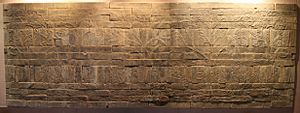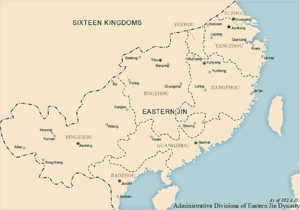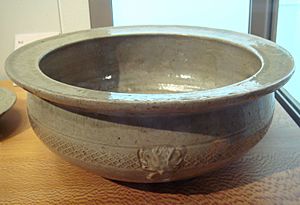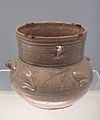Jin dynasty (266–420) facts for kids
Quick facts for kids
Jin
晉
|
|||||||||||||
|---|---|---|---|---|---|---|---|---|---|---|---|---|---|
| 8 February 266–10 July 420 | |||||||||||||

The Jin dynasty (yellow) at its greatest extent, c. 280, during the Western Jin dynasty
|
|||||||||||||
| Capital | Luoyang (266–311) Chang'an (312–316) Jiankang (317–420) |
||||||||||||
| Common languages | Middle Chinese | ||||||||||||
| Religion | Buddhism, Daoism, Chinese folk religion | ||||||||||||
| Government | Monarchy | ||||||||||||
| Emperor | |||||||||||||
|
• 266–290 (first)
|
Emperor Wu of Jin | ||||||||||||
|
• 419–420 (last)
|
Emperor Gong of Jin | ||||||||||||
| Chancellor | |||||||||||||
| History | |||||||||||||
|
• Establishment
|
8 February 266 | ||||||||||||
|
• Reunification of China under Jin rule
|
1 May 280 | ||||||||||||
|
• Jin evacuates to region south of the Huai River, Eastern Jin begins
|
317 | ||||||||||||
|
• Abdication to Liu Song
|
10 July 420 | ||||||||||||
| Area | |||||||||||||
| 280 (Western Jin peak) | 3,100,000 km2 (1,200,000 sq mi) | ||||||||||||
| 347 (Eastern Jin peak) | 2,800,000 km2 (1,100,000 sq mi) | ||||||||||||
| Currency | Chinese coin, Cash | ||||||||||||
|
|||||||||||||
| Today part of | China Mongolia North Korea Vietnam |
||||||||||||
| Jin dynasty | |||||||||||||||||||||||||
|---|---|---|---|---|---|---|---|---|---|---|---|---|---|---|---|---|---|---|---|---|---|---|---|---|---|
| Traditional Chinese | 晉朝 | ||||||||||||||||||||||||
| Simplified Chinese | 晋朝 | ||||||||||||||||||||||||
|
|||||||||||||||||||||||||
| Sima Jin | |||||||||||||||||||||||||
| Traditional Chinese | 司馬晉 | ||||||||||||||||||||||||
| Simplified Chinese | 司马晋 | ||||||||||||||||||||||||
|
|||||||||||||||||||||||||
| Liang Jin | |||||||||||||||||||||||||
| Traditional Chinese | 兩晉 | ||||||||||||||||||||||||
| Simplified Chinese | 两晋 | ||||||||||||||||||||||||
| Literal meaning | Two Jins | ||||||||||||||||||||||||
|
|||||||||||||||||||||||||
| Western Jin | |||||||||||||
|---|---|---|---|---|---|---|---|---|---|---|---|---|---|
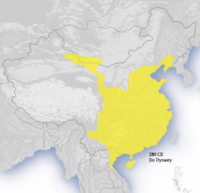
The Jin Empire (yellow), c. 280
(Western Jin) |
|||||||||||||
| Traditional Chinese | 西晉 | ||||||||||||
| Simplified Chinese | 西晋 | ||||||||||||
|
|||||||||||||
| Eastern Jin | |||||||||||||
|---|---|---|---|---|---|---|---|---|---|---|---|---|---|

The Jin Empire (yellow), c. 400
(Eastern Jin) |
|||||||||||||
| Traditional Chinese | 東晉 | ||||||||||||
| Simplified Chinese | 东晋 | ||||||||||||
|
|||||||||||||
The Jin dynasty (Chinese: 晉朝; pinyin: Jìn Cháo) was a powerful Chinese dynasty that ruled from 266 to 420 AD. It is also known as the Jin Empire. Sometimes, people call it the Sima Jin or the Two Jins to tell it apart from other dynasties with the same name.
This dynasty was started by Sima Yan. He was the eldest son of Sima Zhao, who was a very important leader. The Jin dynasty came after the Three Kingdoms period (220–280 AD). It brought China proper back together after conquering the Eastern Wu kingdom.
The Jin dynasty is split into two main parts. The Western Jin (266–316) began after Sima Yan took over the throne from the Cao Wei kingdom. Its first capital was Luoyang, then later Chang'an. Western Jin reunited China in 281.
However, this unity did not last long. The dynasty faced big problems like the War of the Eight Princes and invasions from groups called the Five Barbarians. These groups set up their own states in northern China. After the capital Chang'an fell in 316, the Western Jin dynasty ended.
Survivors of the Jin royal family, led by Sima Rui, moved south. They settled in Jiankang (modern Nanjing) and started the Eastern Jin (317–420). This part of the dynasty lasted for about 100 years, even with constant threats from the north. Eventually, a general named Liu Yu took over in 420. He started a new dynasty called the Liu Song. The Western and Eastern Jin dynasties are part of a group known as the Six Dynasties.
Contents
The Jin Dynasty Story
How the Jin Dynasty Began
During the Three Kingdoms period, the Sima family became very powerful in northern China. This was especially true after an important event in 249, where the Sima clan gained more control than the Cao clan.
After Sima Yi, a key Sima leader, died, his sons continued to grow the family's power. His son, Sima Zhao, became the King of Jin. This title was named after an old Zhou-era area. Sima Zhao wanted to become emperor, but he died in 265 before he could. His ambitious son, Sima Yan, took over the kingdom.
Founding the Jin Empire
The Jin dynasty was officially started in 266 AD by Sima Yan. He is known as Emperor Wu. He made the last emperor of Cao Wei step down, but allowed him to live peacefully. In 280, the Jin dynasty conquered Eastern Wu, finally uniting China.
However, this unity was short-lived. The country soon became weak due to corruption and internal fights. Emperor Wu's son, Emperor Hui, had developmental disabilities, which caused problems for the empire.
The Decline of Jin Power
A big fight over who would rule next, called the War of the Eight Princes, started in 290. This war greatly weakened the dynasty. Then, the Uprising of the Five Barbarians began, and the Jin dynasty lost control of northern China. Many Chinese people had to flee south from the Central Plains.
The Jin capital, Luoyang, was captured in 311. The emperor, Emperor Huai, was taken prisoner and later killed. His successor, Emperor Min, was captured in Chang'an in 316 and also executed.
The Eastern Jin Period
After these defeats, the remaining Jin court members escaped to the southeast. They set up their new government in Jiankang (modern Nanjing). Sima Rui became the new emperor in 318. The northern states, which were now rivals, sometimes called his state "Langya" because they did not accept his rule.
At first, people in the south were not sure about the new ruler from the north. The Eastern Jin emperors had to rely on both local families and powerful families from the north. These powerful families, called menfa (gentry clans), had a lot of control over the country. The emperor's power was limited. There was even a saying that "Wang Dao and Emperor Sima Rui, they rule the nation together."
There were also conflicts between the local families and the immigrant families. These tensions caused problems in Jin's politics. Military problems, including rebellions by generals, also troubled the Eastern Jin for its entire 104 years.
Many Han Chinese people moved from the north to the south during this time. Special areas and records were made for these immigrants. The rich families in southern China were often descendants of these northern migrants. Southern China grew in population as people moved away from the north.
The Eastern Jin dynasty regained its strength when the Former Qin invaded in 383. A great victory at the Battle of Fei River happened because different groups worked together. After this battle, the Jin dynasty took back a lot of land from Former Qin.
The End of the Jin Dynasty
Later, a general named Huan Xuan took over the throne, starting his own short-lived dynasty. But he was soon overthrown by Liu Yu. Liu Yu put Sima Dezong back on the throne. However, there were more revolts, and a region called Western Shu became independent.
Liu Yu had Sima Dezong killed and replaced him with his brother, Sima Dewen, in 419. In 420, Sima Dewen gave up his throne to Liu Yu. Liu Yu then declared himself the ruler of the Song dynasty. Sima Dewen was killed the next year. In the north, the Northern Wei conquered the last of the Sixteen Kingdoms in 439, starting the Northern dynasties period.
Some Jin refugees, like Sima Fei and Sima Chuzhi, were accepted by the Xianbei Northern Wei dynasty. They even married Xianbei princesses. Much later, a famous historian named Sima Guang (1019–1086) claimed to be a descendant of the Jin dynasty.
Government and People
How the Jin Dynasty Managed People
When the Five Barbarians rose up, many people from the north moved to the south. These immigrants were called "qiaoren" (lodged people). They made up about one-sixth of the population in the south. Many of these refugees had lost everything. So, they were allowed to be free from certain taxes and services. Their special records were kept on white papers, called baiji. Regular citizens' records were on yellow papers, called huangji.
Over time, this special treatment for immigrants became a problem. It was expensive for the country and made the native people unhappy. So, the government started a policy called tu duan to fix this.
Lodged Administrative Divisions
The Eastern Jin court created "lodged administrative divisions" for the qiaoren. These were like local governments in exile. They had three levels: lodged provinces, lodged commanderies, and lodged counties. These divisions did not control actual land. Instead, they were a way for the Jin dynasty to show that they still claimed the northern territories. They also helped comfort the refugees who missed their homes.
These divisions were mostly in the areas south of the Huai River and the Lower Yangtze Plain. For example, a lodged Langya Commandery was set up in Jiankang. This helped manage the large number of people who had moved south.
The Tu Duan Policy
The tu duan policy was a way to register people based on where they lived now. It was meant to make the ancient hukou system work better. This policy was first suggested during the Western Jin. But it was really put into action during the Eastern Jin and later Southern dynasties.
This policy helped the government keep track of people and collect taxes more fairly. It also helped to reduce the burden of the special treatment given to the refugees.
Art and Beliefs
Jin Dynasty Art
The Jin dynasty is famous for its beautiful greenish celadon porcelain. This type of pottery was developed right after proto-celadon. The jars often had designs of animals and Buddhist figures.
Examples of Yue ware pottery are also found from the Jin dynasty.
Religious Beliefs
Taoism was a very important religion during the Jin dynasty. The emperors sometimes tried to control Taoists. However, many merchants, landowners, and other people found comfort in Taoist teachings. Some powerful families and military leaders also followed this faith.
A famous Taoist, Ge Hong, taught that being loyal to the emperor was a Taoist virtue. He even said that rebels could not become Taoist immortals. This made Taoism more acceptable to the rulers. So, official Taoist schools were supported, while popular ones were practiced secretly by ordinary people.
The time of disunity and chaos also made Buddhism more popular. This was partly because Buddhism focuses on how to deal with suffering. The Jin dynasty was a key time for Mahayana Buddhism in China. A very important translation of the Lotus Sutra was made in 286. It is said that there were 1,768 Buddhist temples in the Eastern Jin.
Taoism also helped advance chemistry and medicine in China. Buddhism, on the other hand, contributed a lot to philosophy and literature.
Jin Dynasty Emperors
| Posthumous names | Family name and given names | Durations of reigns | Era names and their according range of years |
|---|---|---|---|
| Western Jin dynasty 266–316 | |||
| Wu | Sima Yan | 266–290 |
|
| Hui | Sima Zhong | 290–307 |
|
| none | Sima Lun | 301 |
|
| Huai | Sima Chi | 307–311 |
|
| Min | Sima Ye | 313–316 |
|
| Eastern Jin dynasty 317–420 | |||
| Yuan | Sima Rui | 317–323 |
|
| Ming | Sima Shao | 323–325 |
|
| Cheng | Sima Yan | 325–342 |
|
| Kang | Sima Yue | 342–344 |
|
| Mu | Sima Dan | 344–361 |
|
| Ai | Sima Pi | 361–365 |
|
| none | Sima Yi | 365–372 |
|
| Jianwen | Sima Yu | 372 |
|
| Xiaowu | Sima Yao | 372–396 |
|
| An | Sima Dezong | 396–419 |
|
| Gong | Sima Dewen | 419–420 |
|
Important Events
- Battle of Fei River
- Butterfly Lovers
- War of the Eight Princes
- Wu Hu people
Images for kids
-
Hunping jar of the Western Jin, with Buddhist figures.
-
Celadon lion-shaped bixie, Western Jin, 265–317 CE.
See also
 In Spanish: Dinastía Jin (266-420) para niños
In Spanish: Dinastía Jin (266-420) para niños



